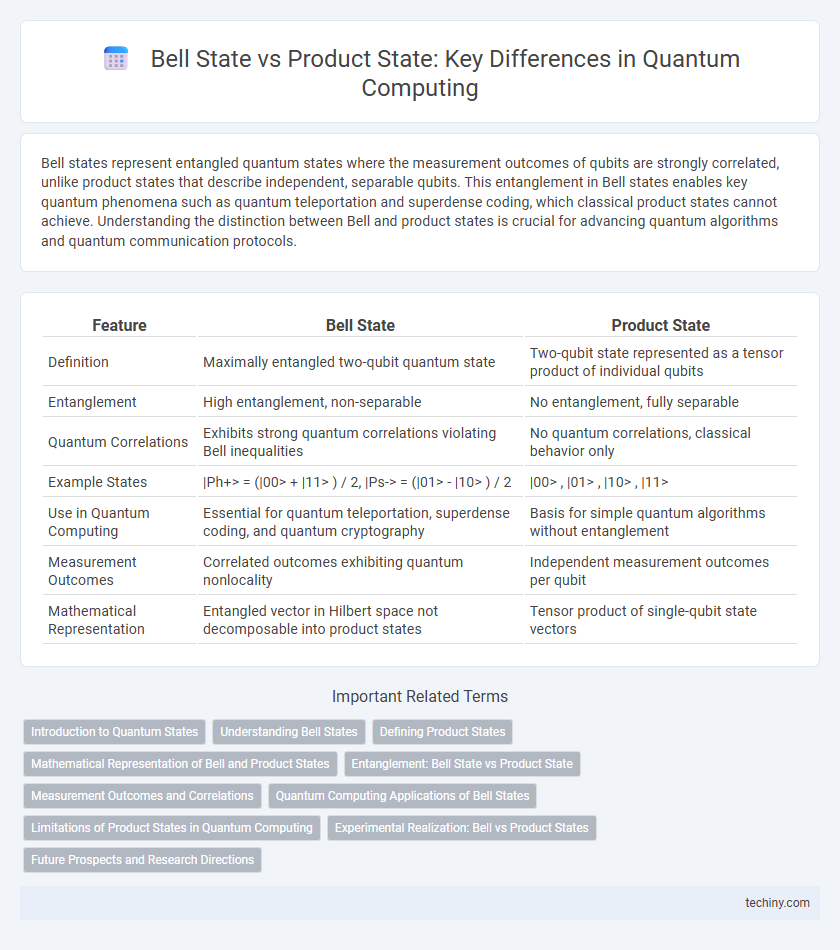Bell states represent entangled quantum states where the measurement outcomes of qubits are strongly correlated, unlike product states that describe independent, separable qubits. This entanglement in Bell states enables key quantum phenomena such as quantum teleportation and superdense coding, which classical product states cannot achieve. Understanding the distinction between Bell and product states is crucial for advancing quantum algorithms and quantum communication protocols.
Table of Comparison
| Feature | Bell State | Product State |
|---|---|---|
| Definition | Maximally entangled two-qubit quantum state | Two-qubit state represented as a tensor product of individual qubits |
| Entanglement | High entanglement, non-separable | No entanglement, fully separable |
| Quantum Correlations | Exhibits strong quantum correlations violating Bell inequalities | No quantum correlations, classical behavior only |
| Example States | |Ph+> = (|00> + |11> ) / 2, |Ps-> = (|01> - |10> ) / 2 | |00> , |01> , |10> , |11> |
| Use in Quantum Computing | Essential for quantum teleportation, superdense coding, and quantum cryptography | Basis for simple quantum algorithms without entanglement |
| Measurement Outcomes | Correlated outcomes exhibiting quantum nonlocality | Independent measurement outcomes per qubit |
| Mathematical Representation | Entangled vector in Hilbert space not decomposable into product states | Tensor product of single-qubit state vectors |
Introduction to Quantum States
Bell states represent a fundamental type of entangled quantum state involving two qubits, exhibiting non-classical correlations that cannot be described by product states. In contrast, product states describe independent quantum systems with no entanglement, expressed as the tensor product of individual qubit states. Understanding the distinction between Bell states and product states is essential for exploring quantum entanglement and its applications in quantum computing protocols such as teleportation and superdense coding.
Understanding Bell States
Bell states are specific quantum states of two qubits that represent the simplest examples of quantum entanglement, showing perfect correlations regardless of the measurement basis. Unlike product states, which are separable and can be described independently, Bell states cannot be factored into individual qubit states, highlighting their inseparable quantum nature. Understanding Bell states is crucial for quantum information processing tasks such as quantum teleportation, superdense coding, and entanglement-based quantum cryptography.
Defining Product States
Product states in quantum computing refer to multi-qubit systems where each qubit is described independently, resulting in a composite state expressed as the tensor product of individual qubit states. Unlike Bell states, which are entangled and cannot be factored into single-qubit states, product states exhibit no quantum entanglement and are separable. Defining product states is crucial for understanding the distinction between classical correlations and genuine quantum entanglement in quantum information processing.
Mathematical Representation of Bell and Product States
Bell states are maximally entangled quantum states represented mathematically as \(|\Phi^{+}\rangle = \frac{1}{\sqrt{2}}(|00\rangle + |11\rangle)\), \(|\Phi^{-}\rangle = \frac{1}{\sqrt{2}}(|00\rangle - |11\rangle)\), \(|\Psi^{+}\rangle = \frac{1}{\sqrt{2}}(|01\rangle + |10\rangle)\), and \(|\Psi^{-}\rangle = \frac{1}{\sqrt{2}}(|01\rangle - |10\rangle)\), showcasing perfect quantum correlations. Product states, in contrast, are separable states expressed as \(|\psi\rangle \otimes |\phi\rangle\), where each qubit state \(|\psi\rangle\) and \(|\phi\rangle\) can be independently described, such as \(|0\rangle \otimes |1\rangle = |01\rangle\). The mathematical representation fundamentally distinguishes entanglement, with Bell states unable to be decomposed into product states unlike separable product states.
Entanglement: Bell State vs Product State
Bell states represent maximally entangled quantum states, exhibiting strong correlations between qubits that cannot be explained classically, while product states are separable and lack entanglement, meaning the state of each qubit can be described independently. Entanglement in Bell states enables quantum phenomena such as superdense coding and quantum teleportation, which are not possible with product states. The fundamental difference lies in the nonlocal correlations present in Bell states compared to the independent probabilities of measurement outcomes in product states.
Measurement Outcomes and Correlations
Bell states exhibit strong quantum correlations with measurement outcomes that are perfectly entangled and violate classical statistical predictions, enabling phenomena like quantum teleportation and superdense coding. In contrast, product states yield measurement outcomes that are statistically independent, reflecting no entanglement or quantum correlation between qubits. These differences in measurement statistics are fundamental for quantum algorithms relying on nonlocal correlations characteristic of Bell states.
Quantum Computing Applications of Bell States
Bell states, exemplifying maximal entanglement of two qubits, are fundamental in quantum computing applications such as quantum teleportation, superdense coding, and entanglement-based quantum cryptography. Unlike product states, which represent independent qubits without quantum correlations, Bell states enable non-classical correlations crucial for quantum algorithms and error correction protocols. Their use in quantum communication and distributed computing enhances the performance and security of quantum networks.
Limitations of Product States in Quantum Computing
Product states in quantum computing lack entanglement, limiting their ability to represent complex quantum correlations essential for quantum algorithms. Without entanglement, product states cannot exploit quantum parallelism or perform tasks such as quantum teleportation and superdense coding, which rely on Bell states. This fundamental limitation restricts product states from achieving exponential speedup in quantum computations compared to entangled states.
Experimental Realization: Bell vs Product States
Bell states demonstrate genuine quantum entanglement, experimentally realized through precise manipulation of qubits in systems such as trapped ions, superconducting circuits, or photonic setups, ensuring nonlocal correlations unachievable by product states. Product states, representing independent qubits with no entanglement, are simpler to prepare and control but lack the quantum advantages harnessed in Bell states for tasks like quantum teleportation and superdense coding. Experimental realization of Bell states demands intricate control over decoherence and crosstalk to maintain coherence, contrasting with the straightforward initialization of product states.
Future Prospects and Research Directions
Research in quantum computing increasingly explores Bell states for their entanglement properties, critical to advancements in quantum communication and error correction. Future prospects include leveraging Bell states in scalable quantum networks and enhancing quantum cryptography protocols, surpassing the limitations of product states. Ongoing investigations aim to optimize the generation and manipulation of Bell states to improve quantum algorithm efficiency and hardware robustness.
Bell State vs Product State Infographic

 techiny.com
techiny.com